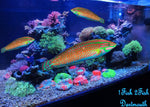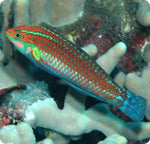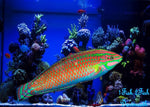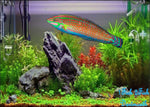The Christmas Wrasse has red striped or checkerboard-like markings along its body with greenish markings around its face. Juveniles and females are more striped and have two black spots on the dorsal fin. This is one of several wrasses known commonly as "Christmas Wrasses".
Wrasses from the Halichoeres and Thalassoma genera are some of the most active in the wrasse group. Most are narrow and torpedo-shaped. While Thalassoma wrasses are often in the upper to mid-water ranges of the aquarium, Halichoeres wrasses are often closer to the substrate or rockwork, especially when young. They also bury themselves in the substrate when resting or threatened. Because of this behavior, Halichoeres wrasses are often confused with some Coris wrasses. Thalassoma wrasses are also sometimes known as "paddlefin wrasses" due to their use of their pectoral fins while swimming. Longer aquariums with plenty of swimming room are best for these wrasses.
Halichoeres and Thalassoma wrasses are more active and aggressive than many other groups, especially as adults. Tankmates should be around the same size, aggression and activity level; avoid very small or docile tankmates, They should not be kept with invertebrates like crustaceans (crabs and shrimp) or feather duster worms. Some do not bother corals, but they may damage colonies as they search for food and may nip at polyps and fleshier corals. Feed a varied meaty diet of frozen and prepared foods; most wrasses will also graze on microinverts in the aquarium (copepods, amphipods, worms, etc.).
Wrasses from the Halichoeres and Thalassoma genera are some of the most active in the wrasse group. Most are narrow and torpedo-shaped. While Thalassoma wrasses are often in the upper to mid-water ranges of the aquarium, Halichoeres wrasses are often closer to the substrate or rockwork, especially when young. They also bury themselves in the substrate when resting or threatened. Because of this behavior, Halichoeres wrasses are often confused with some Coris wrasses. Thalassoma wrasses are also sometimes known as "paddlefin wrasses" due to their use of their pectoral fins while swimming. Longer aquariums with plenty of swimming room are best for these wrasses.
Halichoeres and Thalassoma wrasses are more active and aggressive than many other groups, especially as adults. Tankmates should be around the same size, aggression and activity level; avoid very small or docile tankmates, They should not be kept with invertebrates like crustaceans (crabs and shrimp) or feather duster worms. Some do not bother corals, but they may damage colonies as they search for food and may nip at polyps and fleshier corals. Feed a varied meaty diet of frozen and prepared foods; most wrasses will also graze on microinverts in the aquarium (copepods, amphipods, worms, etc.).












